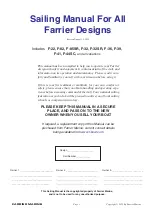
/ 12
10
PRESSURE
The correct pressure for the buoyancy tube and the keel is 240 mb (3.48 PSI) and the
correct pressure for the Aerotech inflatable bottom is 600 mb (8.5 PSI).
If your boat is not equipped with an ACCESS pressure indicator, we recommend that you purchase
one from your dealer. This will permit a quick and efficient control of the pressure during inflation.
Without a pressure indicator, stop inflating when buoyancy tube is sufficiently hard so that the cones on
the aft section of the buoyancy tube cannot be bent by hand.
The ambient temperature of the air or
Ambient temperature
Buoyancy tube internal pressure
water proportionately influences the
+1°C
+4 mb / 0 .06 PSI
level of internal pressure in the buoyancy
chamber
-1°C
-4 mb / 0.06 PSI
Thus, it is important to anticipate:
Check and adjust the pressure of the inflatable compartments (inflating or deflating according
to the case) according to the temperature variations (especially when there is a considerable
difference in temperature between morning and evening in particularly hot areas) and make
sure that the pressure remains within the recommended pressure range (from 220 to 270 mb /
green sector).
RISK OF UNDERPRESSURE
EXAMPLE: Your boat is exposed to direct sunlight on the beach (temperature=50°C) at the
recommended pressure (240 mb/3.48 PSI). When you launch it (temperature=20°C), the temperature
and internal pressure of the inflatable compartments will drop simultaneously (up to 120 mb) and YOU
WILL THEN NEED TO REINFLATE until you regain the millibars lost due to the difference between
the ambient air and water temperatures. A drop in pressure at the end of the day, when the outside
temperature is dropping, is normal.
NOTE:
Proper inflation is critical to the performance of the boat. It is the pressure in
the tubes that gives your boat the necessary rigidity to perform well. Under-
inflation causes improper flexing of the tubes which will cause early aging.
RISK OF OVERPRESSURE
EXAMPLE: Your boat is inflated to its recommended pressure (240 mb/3.48 PSI) at the
beginning or end of the day (low outside temperature = 10°C). Later in the day, your boat is exposed i n
the sun on the beach or on a yacht deck (temperature = 50°C). The temperature inside the inflatable
compartments may rise to 70°C (particularly for dar k buoyancy chambers), doubling the initial pressure
(480 mb). YOU WILL THEN NEED TO DEFLATE the boat to return to the recommended pressure.
CAUTION
IF YOUR BOAT IS OVERINFLATED, THERE WILL BE UNDUE PRESSURE
ON THE INFLATABLE STRUCTURE THAT MAY RUPTURE IT.
IN THE EVENT OF OVERPRESSURE
Deflate by pressing the spring
loaded button
.






























